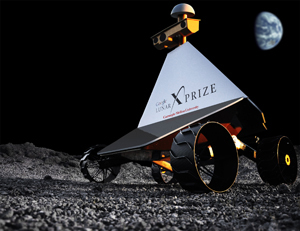News Brief: Mission Moves Forward
Astrobotic Signs Contract for SpaceX To Launch Robot to Moon
 Astrobotic Technology Inc., the Carnegie Mellon University spin-off headed by William "Red" Whittaker, has signed a contract with SpaceX to launch Astrobotic's exploration robot to the Moon atop one of the company's Falcon 9 boosters. The mission could launch as soon as December 2013.
Astrobotic Technology Inc., the Carnegie Mellon University spin-off headed by William "Red" Whittaker, has signed a contract with SpaceX to launch Astrobotic's exploration robot to the Moon atop one of the company's Falcon 9 boosters. The mission could launch as soon as December 2013.SpaceX, headed by CEO Elon Musk, the co-founder of PayPal, is developing a family of launch vehicles and spacecraft for boosting commercial satellites into orbit and carrying cargo to and from the International Space Station. Popular Science last year named the Falcon 9 the winner of a Best of What's New Award in Aviation & Space, calling it "The First Astronaut-Worthy Private Rocket In Orbit."
The Falcon 9 will enable Astrobotic to deliver 240 pounds of payload to the moon, in addition to the robot. The company plans to sell that extra payload capacity to space agencies and corporate marketers to help pay for the mission. The company also anticipates receiving up to $24 million by winning the Google Lunar X Prize and $2 million from the state of Florida as a launch bonus. Last year, NASA awarded Astrobotic a $10 million contract through its Innovative Lunar Demonstrations Data (ILDD) program for data to be gathered before and during the expedition.
"The mission is the first of a serial campaign," said Whittaker, Astrobotic chairman, founder of the Robotics Institute's Field Robotics Center, and research professor of robotics. "Astrobotic's missions will pursue new resources, deliver rich experiences, serve new customers and open new markets. Spurred further by incentives, contracts, and the Google Lunar X Prize, this is a perfect storm for new exploration."
Astrobotic is now the only team competing for the Google Lunar X Prize that has a contract for a launch vehicle in hand, said David Gump, Astrobotic president. But he emphasized that the X Prize competition is only one of the company's goals. The company is planning multiple missions as it seeks to carve out a commercial niche delivering scientific payloads to the Moon, gathering and selling lunar data to agencies and companies and performing contracted scientific and engineering experiments.
"The moon has economic and scientific treasures that went undiscovered during the Apollo era, and our robot explorers will spearhead this new lunar frontier," Gump said.
The Falcon 9 launch vehicle is powered by a cluster of nine SpaceX-designed and -developed Merlin engines. Using ultra pure jet fuel and liquid oxygen, the engines generate nearly a million pounds of thrust.
In the first mission, the Falcon 9 upper stage will sling Astrobotic's payload on a four-day cruise to the Moon. After orbiting the Moon to align itself, the spacecraft will land softly, precisely and safely using technologies pioneered by Carnegie Mellon for guiding autonomous cars. The four-wheeled rover will beam high-definition video back to Earth. Its exploration mission likely will continue for three months, with the solar-powered robot operating continuously during the lunar days and hibernating through the lunar nights. The lander will sustain payload operations with generous power and communications.
In addition to Carnegie Mellon, where several prototypes have been built and tested, the mission is supported by industrial partners such as International Rectifier Corporation and corporate sponsors such as Caterpillar Inc. and ANSYS Inc.
For more information, visit the Astrobotic website, http://astrobotic.net/.